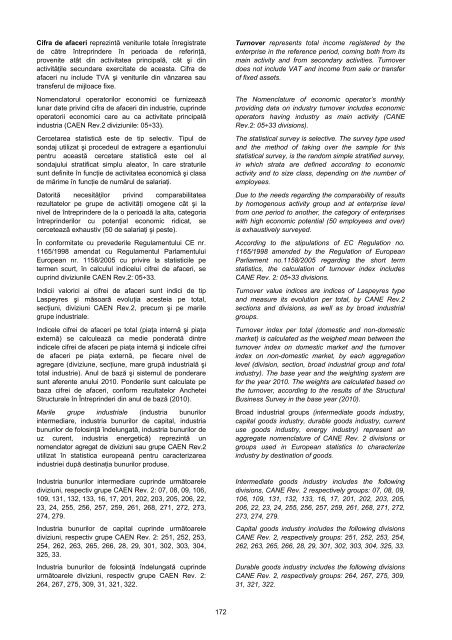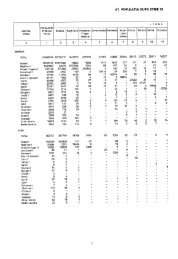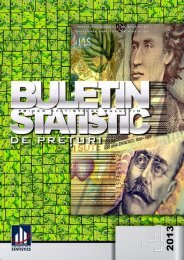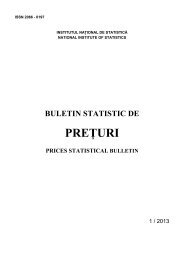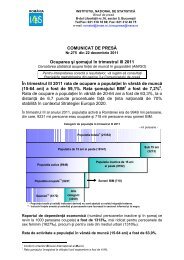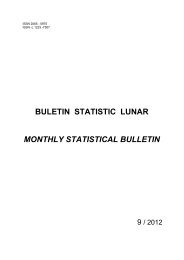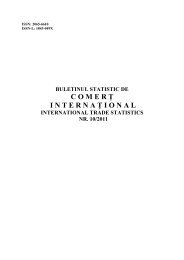Indicii producţiei industriale pe total industrie se obţinprin agregarea indicilor calculaţi la nivel <strong>de</strong> diviziuneCAEN Rev. 2.Pe lângă indicii bruţi ai producţiei industriale, secalculează lunar şi indici ajustaţi cu numărul <strong>de</strong> zilelucrătoare prin metoda regresivă, metodărecomandată <strong>de</strong> regulamentele europene referitoare laindicatorii pe termen scurt (Regulamentul Consiliului nr.1165/1998).Pentru ajustarea seriilor (nivel, diviziune, secţiune, totalindustrie - CAEN Rev. 2, mare grupă industrială) s-afolosit pachetul <strong>de</strong> programe DEMETRA (metodaTRAMO/SEATS), care realizează estimarea efectuluinumărului <strong>de</strong> zile lucrătoare diferit <strong>de</strong> la o lună la alta şiefectului calendarului (an bisect şi alte sărbătorinaţionale) precum şi i<strong>de</strong>ntificarea şi corectarea valorilorextreme (schimbări <strong>de</strong> nivel ocazionale, tranzitorii saupermanente) şi interpolarea valorilor lipsă.Seria ajustată cu numărul <strong>de</strong> zile lucrătoare s-a obţinutprin eliminarea din seria brută a acestor efecte, cuajutorul unor coeficienţi <strong>de</strong> corecţie, stabiliţi în funcţie<strong>de</strong> mo<strong>de</strong>lul <strong>de</strong> regresie folosit (aditiv sau multiplicativ).Stabilirea mo<strong>de</strong>lelor <strong>de</strong> regresie folosite pentru fiecareserie se face la începutul fiecărui an şi implicărecalcularea seriilor ajustate calculate în anul prece<strong>de</strong>nt(recalculare datorată modificării mo<strong>de</strong>lelor adoptate,numărului <strong>de</strong> regresori folosit şi numărului <strong>de</strong> observaţiidisponibile).Ajustarea nivelurilor agregate (secţiune, total industrie,mari grupe industriale) s-a realizat prin metoda directăcare presupune ajustarea directă a seriilor agregate.Utilizarea meto<strong>de</strong>i directe poate conduce la uneleinconsistenţe în seriile <strong>de</strong> date (respectiv, agregatele sănu fie cuprinse întot<strong>de</strong>una între valorile componentelordin care provin).Indicii producţiei industriale sunt provizorii şi serevizuiesc pe baza rectificărilor ce se efectueazăretroactiv <strong>de</strong> către întreprin<strong>de</strong>rile din eşantion, asupradatelor furnizate anterior <strong>de</strong> către acestea.The industrial production indices per total industry areobtained by the aggregation of indices calculated at thelevel of the CANE Rev. 2 division.Besi<strong>de</strong>s gross indices of industrial production, indicesadjusted with working days number are also monthlycalculated by means of the regressive method, whichis recommen<strong>de</strong>d by European regulations regarding theshort-term indicators (Council Regulation no.1165/1998).In or<strong>de</strong>r to adjust the series (level, division, section,total industry – CANE Rev. 2, broad industrial group)DEMETRA programs package (TRAMO/SEATSmethod) was used, estimating the effect of workingdays number, different from one month to another andthe calendar effect (leap year and other nationalholidays) as well as for the i<strong>de</strong>ntification and correctionof outliers (occasional, transitional or permanentchanges) and interpolation of missing values.The series adjusted with working days number wasobtained by eliminating from unadjusted series theseeffects, by means of correction coefficients, set upaccording to the regression mo<strong>de</strong>l used (additive ormultiplicative).Regression mo<strong>de</strong>ls used for each series are set up atthe beginning of each year, involving the recalculationof adjusted series calculated in the previous year(recalculation due to the change in the adopted mo<strong>de</strong>ls,number of regressors used and number of availableobservations).Aggregated levels (section, total industry, broadindustrial groups) were adjusted by means of directmethod supposing direct adjustment of aggregatedseries. The use of the direct method could lead to someinconsistencies in data series (respectively, aggregatescould not always range between the values of theiroriginal components).The industrial production indices are provisional andare revised based on the corrections retroactively doneby the enterprises in the sample, concerning the datapreviously provi<strong>de</strong>d.Indicele productivităţii muncii în industrieIndicele productivităţii muncii în industrie esteindicatorul ce caracterizează eficienţa muncii <strong>de</strong>puseîntr-o anumită perioadă în cadrul activităţii industriale şise calculează ca raport între indicele brut al producţieiindustriale şi indicele numărului mediu <strong>de</strong> salariaţi dinindustrie.Indicii productivităţii muncii în industrie sunt calculaţi petotal industrie, secţiuni (industria extractivă,prelucrătoare şi producţia şi furnizarea <strong>de</strong> energieelectrică şi termică, gaze, apă caldă şi aer condiţionat),diviziuni CAEN Rev.2, precum şi pe marile grupeindustriale.Indicii lunari ai productivităţii muncii în industrie suntprovizorii şi se revizuiesc pe baza rectificărilor ce seefectuează retroactiv <strong>de</strong> către operatorii economici dineşantion.Labour productivity in<strong>de</strong>x in industryLabour productivity in<strong>de</strong>x in industry is the indicatorwhich characterizes the efficiency of work carried outduring a certain period of time within the industrialactivity and is calculated as ratio between the grossindustrial production in<strong>de</strong>x and the in<strong>de</strong>x of averagenumber of employees in industry.Labour productivity indices in industry are calculatedper total industry, by CANE Rev 2 sections (mining andquarrying, manufacturing and electricity, gas, steamand air conditioning production and supply) anddivisions, as well as by broad industrial groups.Monthly labour productivity indices in industry areprovisional and they are revised on the basis ofretroactive corrections ma<strong>de</strong> by economic operatorsfrom the sample.171
Cifra <strong>de</strong> afaceri reprezintă veniturile totale înregistrate<strong>de</strong> către întreprin<strong>de</strong>re în perioada <strong>de</strong> referinţă,provenite atât din activitatea principală, cât şi dinactivităţile secundare exercitate <strong>de</strong> aceasta. Cifra <strong>de</strong>afaceri nu inclu<strong>de</strong> TVA şi veniturile din vânzarea sautransferul <strong>de</strong> mijloace fixe.Nomenclatorul operatorilor economici ce furnizeazălunar date privind cifra <strong>de</strong> afaceri din industrie, cuprin<strong>de</strong>operatorii economici care au ca activitate principalăindustria (CAEN Rev.2 diviziunile: 05÷33).Cercetarea statistică este <strong>de</strong> tip selectiv. Tipul <strong>de</strong>sondaj utilizat şi proce<strong>de</strong>ul <strong>de</strong> extragere a eşantionuluipentru această cercetare statistică este cel alsondajului stratificat simplu aleator, în care straturilesunt <strong>de</strong>finite în funcţie <strong>de</strong> activitatea economică şi clasa<strong>de</strong> mărime în funcţie <strong>de</strong> numărul <strong>de</strong> salariaţi.Datorită necesităţilor privind comparabilitatearezultatelor pe grupe <strong>de</strong> activităţi omogene cât şi lanivel <strong>de</strong> întreprin<strong>de</strong>re <strong>de</strong> la o perioadă la alta, categoriaîntreprin<strong>de</strong>rilor cu potenţial economic ridicat, secercetează exhaustiv (50 <strong>de</strong> salariaţi şi peste).În conformitate cu preve<strong>de</strong>rile Regulamentului CE nr.1165/1998 amendat cu Regulamentul ParlamentuluiEuropean nr. 1158/2005 cu privire la statisticile petermen scurt, în calculul indicelui cifrei <strong>de</strong> afaceri, secuprind diviziunile CAEN Rev.2: 05÷33.Indicii valorici ai cifrei <strong>de</strong> afaceri sunt indici <strong>de</strong> tipLaspeyres şi măsoară evoluţia acesteia pe total,secţiuni, diviziuni CAEN Rev.2, precum şi pe marilegrupe industriale.Indicele cifrei <strong>de</strong> afaceri pe total (piaţa internă şi piaţaexternă) se calculează ca medie pon<strong>de</strong>rată dintreindicele cifrei <strong>de</strong> afaceri pe piaţa internă şi indicele cifrei<strong>de</strong> afaceri pe piaţa externă, pe fiecare nivel <strong>de</strong>agregare (diviziune, secţiune, mare grupă industrială şitotal industrie). Anul <strong>de</strong> bază şi sistemul <strong>de</strong> pon<strong>de</strong>raresunt aferente anului 2010. Pon<strong>de</strong>rile sunt calculate pebaza cifrei <strong>de</strong> afaceri, conform rezultatelor AncheteiStructurale în Întreprin<strong>de</strong>ri din anul <strong>de</strong> bază (2010).Marile grupe industriale (industria bunurilorintermediare, industria bunurilor <strong>de</strong> capital, industriabunurilor <strong>de</strong> folosinţă în<strong>de</strong>lungată, industria bunurilor <strong>de</strong>uz curent, industria energetică) reprezintă unnomenclator agregat <strong>de</strong> diviziuni sau grupe CAEN Rev.2utilizat în statistica europeană pentru caracterizareaindustriei după <strong>de</strong>stinaţia bunurilor produse.Industria bunurilor intermediare cuprin<strong>de</strong> următoarelediviziuni, respectiv grupe CAEN Rev. 2: 07, 08, 09, 106,109, 131, 132, 133, 16, 17, 201, 202, 203, 205, 206, 22,23, 24, 255, 256, 257, 259, 261, 268, 271, 272, 273,274, 279.Industria bunurilor <strong>de</strong> capital cuprin<strong>de</strong> următoarelediviziuni, respectiv grupe CAEN Rev. 2: 251, 252, 253,254, 262, 263, 265, 266, 28, 29, 301, 302, 303, 304,325, 33.Industria bunurilor <strong>de</strong> folosinţă în<strong>de</strong>lungată cuprin<strong>de</strong>următoarele diviziuni, respectiv grupe CAEN Rev. 2:264, 267, 275, 309, 31, 321, 322.Turnover represents total income registered by theenterprise in the reference period, coming both from itsmain activity and from secondary activities. Turnoverdoes not inclu<strong>de</strong> VAT and income from sale or transferof fixed assets.The Nomenclature of economic operator’s monthlyproviding data on industry turnover inclu<strong>de</strong>s economicoperators having industry as main activity (CANERev.2: 05÷33 divisions).The statistical survey is selective. The survey type usedand the method of taking over the sample for thisstatistical survey, is the random simple stratified survey,in which strata are <strong>de</strong>fined according to economicactivity and to size class, <strong>de</strong>pending on the number ofemployees.Due to the needs regarding the comparability of resultsby homogenous activity group and at enterprise levelfrom one period to another, the category of enterpriseswith high economic potential (50 employees and over)is exhaustively surveyed.According to the stipulations of EC Regulation no.1165/1998 amen<strong>de</strong>d by the Regulation of EuropeanParliament no.1158/2005 regarding the short termstatistics, the calculation of turnover in<strong>de</strong>x inclu<strong>de</strong>sCANE Rev. 2: 05÷33 divisions.Turnover value indices are indices of Laspeyres typeand measure its evolution per total, by CANE Rev.2sections and divisions, as well as by broad industrialgroups.Turnover in<strong>de</strong>x per total (domestic and non-domesticmarket) is calculated as the weighed mean between theturnover in<strong>de</strong>x on domestic market and the turnoverin<strong>de</strong>x on non-domestic market, by each aggregationlevel (division, section, broad industrial group and totalindustry). The base year and the weighting system arefor the year 2010. The weights are calculated based onthe turnover, according to the results of the StructuralBusiness Survey in the base year (2010).Broad industrial groups (intermediate goods industry,capital goods industry, durable goods industry, currentuse goods industry, energy industry) represent anaggregate nomenclature of CANE Rev. 2 divisions orgroups used in European statistics to characterizeindustry by <strong>de</strong>stination of goods.Intermediate goods industry inclu<strong>de</strong>s the followingdivisions, CANE Rev. 2 respectively groups: 07, 08, 09,106, 109, 131, 132, 133, 16, 17, 201, 202, 203, 205,206, 22, 23, 24, 255, 256, 257, 259, 261, 268, 271, 272,273, 274, 279.Capital goods industry inclu<strong>de</strong>s the following divisionsCANE Rev. 2, respectively groups: 251, 252, 253, 254,262, 263, 265, 266, 28, 29, 301, 302, 303, 304, 325, 33.Durable goods industry inclu<strong>de</strong>s the following divisionsCANE Rev. 2, respectively groups: 264, 267, 275, 309,31, 321, 322.172
- Page 2 and 3:
Institutul Naţional de Statistică
- Page 4 and 5:
ISSN 2066 - 0693ISSN-L 1223 -7507BU
- Page 6 and 7:
PaginaPageCOMERŢ INTERIOR ........
- Page 8 and 9:
PaginaPageIndicii produsului intern
- Page 10 and 11:
Indicii de preţ ai valorii adăuga
- Page 13 and 14:
B. Evoluţii sectorialeB. Sector ev
- Page 15 and 16:
În luna aprilie 2013, indicele val
- Page 17 and 18:
4. Comerţ şi servicii * )4.1. Com
- Page 19 and 20:
euro), valoarea acestora fiind mai
- Page 21 and 22:
7. Câştiguri salarialeCâştigul
- Page 23 and 24:
Rata locurilor de muncă vacante î
- Page 25 and 26:
INDUSTRIE; INVESTIŢII; CONSTRUCŢI
- Page 27 and 28:
1. INDICII PRODUCŢIEI INDUSTRIALE
- Page 29 and 30:
2. INDICII PRODUCŢIEI INDUSTRIALE
- Page 31 and 32:
2. INDICII PRODUCŢIEI INDUSTRIALE
- Page 33 and 34:
3. INDICII PRODUCŢIEI INDUSTRIALE
- Page 35 and 36:
4. INDICII PRODUCŢIEI INDUSTRIALE
- Page 37 and 38:
4. INDICII PRODUCŢIEI INDUSTRIALE
- Page 39 and 40:
5. INDICII PRODUCTIVITĂŢII MUNCII
- Page 41 and 42:
5. INDICII PRODUCTIVITĂŢII MUNCII
- Page 43 and 44:
6. INDICII PRODUCTIVITĂŢII MUNCII
- Page 45 and 46:
7. INDICII VALORICI AI CIFREI DE AF
- Page 47 and 48:
7. INDICII VALORICI AI CIFREI DE AF
- Page 49 and 50:
8. INDICII VALORICI AI CIFREI DE AF
- Page 51 and 52:
9. INDICII VALORICI AI COMENZILOR N
- Page 53 and 54:
11. INDICII PREŢURILOR PRODUCŢIEI
- Page 55 and 56:
11. INDICII PREŢURILOR PRODUCŢIEI
- Page 57 and 58:
12. INDICII PREŢURILOR PRODUCŢIEI
- Page 59 and 60:
13. PRINCIPALELE RESURSE DE ENERGIE
- Page 61 and 62:
P/P201215. INDICII INVESTIŢIILOR R
- Page 63 and 64:
Investiţiile realizate în economi
- Page 65 and 66:
20. AUTORIZAŢII DE CONSTRUIRE ELIB
- Page 67 and 68:
22. LOCUINŢE TERMINATE, PE SURSE D
- Page 69 and 70:
23. NUMĂRUL ANIMALELOR SACRIFICATE
- Page 71 and 72:
COMERŢ INTERIORDOMESTIC TRADE
- Page 73 and 74:
PVOLUME)P27. INDICII VOLUMULUI CIFR
- Page 75 and 76:
PVOLUME)P29. INDICII VOLUMULUI CIFR
- Page 77 and 78:
PVOLUME)P31. INDICII VOLUMULUI CIFR
- Page 79 and 80:
Indicii volumului cifrei de afaceri
- Page 81 and 82:
PVALUE35. INDICII VALORICI AI CIFRE
- Page 83 and 84:
36. COMERŢUL INTERNAŢIONAL CU BUN
- Page 85 and 86:
39. COMERŢUL INTERNAŢIONAL CU BUN
- Page 87 and 88:
SERVICIISERVICES
- Page 89 and 90:
PVALUE42. INDICII VALORICI AI CIFRE
- Page 91 and 92:
P2011P201244. TRANSPORTUL DE PASAGE
- Page 93 and 94:
46. TRANSPORTUL PORTUAR DE MĂRFURI
- Page 95 and 96:
P48. ÎNMATRICULĂRI NOI DE VEHICUL
- Page 97 and 98:
50. ÎNNOPTĂRI ÎN PRINCIPALELE ST
- Page 99 and 100:
52. SOSIRILE VIZITATORILOR STRĂINI
- Page 101 and 102:
54. EFECTIVUL SALARIAŢILOR DIN ECO
- Page 103 and 104:
54. EFECTIVUL SALARIAŢILOR DIN ECO
- Page 105 and 106:
55. CÂŞTIGUL SALARIAL MEDIU BRUT
- Page 107 and 108:
55. CÂŞTIGUL SALARIAL MEDIU BRUT
- Page 109 and 110:
56. CÂŞTIGUL SALARIAL MEDIU NET *
- Page 111 and 112:
56. CÂŞTIGUL SALARIAL MEDIU NET *
- Page 113 and 114:
57. CÂŞTIGURILE SALARIALE NOMINAL
- Page 115 and 116:
57. CÂŞTIGURILE SALARIALE NOMINAL
- Page 117 and 118:
58. CÂŞTIGURILE SALARIALE MEDII O
- Page 119 and 120:
58. CÂŞTIGURILE SALARIALE MEDII O
- Page 121 and 122:
59. INDICII TRIMESTRIALI AI COSTULU
- Page 123 and 124: 59. INDICII TRIMESTRIALI AI COSTULU
- Page 125 and 126: Evoluţia indicilor preţurilor de
- Page 127 and 128: iun60. INDICII PREŢURILOR DE CONSU
- Page 129 and 130: 64. NUMĂRUL ŞOMERILOR ÎNREGISTRA
- Page 131 and 132: iun66. NUMĂRUL ŞOMERILOR ÎNREGIS
- Page 133 and 134: Rata şomajului în perioada aprili
- Page 135 and 136: 72. NUMĂRUL ŞI RATA LOCURILOR DE
- Page 137 and 138: iun74. MIŞCAREA NATURALĂ A POPULA
- Page 139 and 140: 75. PRODUSUL INTERN BRUT, PE CATEGO
- Page 141 and 142: 76. PRODUSUL INTERN BRUT, PE CATEGO
- Page 143 and 144: 78. INDICII PRODUSULUI INTERN BRUT,
- Page 145 and 146: 79. INDICII PRODUSULUI INTERN BRUT,
- Page 147 and 148: 81. PRODUSUL INTERN BRUT, PE CATEGO
- Page 149 and 150: 83. INDICII PRODUSULUI INTERN BRUT,
- Page 151 and 152: 84. AGREGATELE MACROECONOMICE ALE S
- Page 153 and 154: 84. AGREGATELE MACROECONOMICE ALE S
- Page 155 and 156: 84. AGREGATELE MACROECONOMICE ALE S
- Page 157 and 158: 85. POPULAŢIA OCUPATĂ, PE ACTIVIT
- Page 159 and 160: 86. ORE LUCRATE DE POPULAŢIA OCUPA
- Page 161 and 162: 87. ÎNMATRICULĂRI DE SOCIETĂŢI
- Page 163 and 164: 89. ÎNMATRICULĂRI DE SOCIETĂŢI
- Page 165 and 166: 91. PRINCIPALII INDICATORI AI PIEŢ
- Page 167 and 168: 93. EXECUŢIA BUGETELOR LOCALEEXECU
- Page 169 and 170: 96. EXECUŢIA BUGETULUI FONDULUI NA
- Page 171 and 172: • În Buletinul Statistic Lunar s
- Page 173: Industria energetică cuprinde urm
- Page 177 and 178: Indicele preţurilor producţiei in
- Page 179 and 180: ENERGIEENERGYResursele de energie p
- Page 181 and 182: CONSTRUCŢIICONSTRUCTIONValoarea lu
- Page 183 and 184: Autorizaţia de construire se elibe
- Page 185 and 186: Randamentul mediu se calculează ca
- Page 187 and 188: Stabilirea modelelor de regresie fo
- Page 189 and 190: Repartizarea pe ţări a schimburil
- Page 191 and 192: 2010. Ponderile utilizate la agrega
- Page 193 and 194: împărţirea numărului total de
- Page 195 and 196: salariaţilor reprezintă o medie a
- Page 197 and 198: Cheltuielile directe cu forţa de m
- Page 199 and 200: PREŢURIIndicele preţurilor de con
- Page 201 and 202: Această rată se calculează ca un
- Page 203 and 204: Conform Ordonanţei de Urgenţă nr
- Page 205 and 206: Cele două seturi de indicatori sta
- Page 207 and 208: Divorţul reprezintă desfacerea un
- Page 209 and 210: SPI = subvenţii pe producţie şi
- Page 211 and 212: producţie, precum şi valoarea ser
- Page 213: BVB (cu excepţia SIF).Metoda de ca


